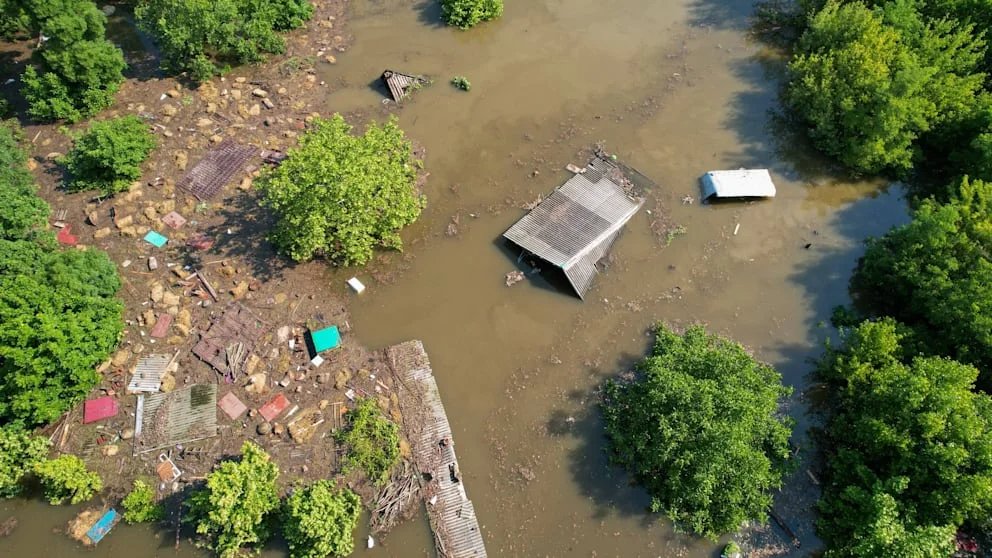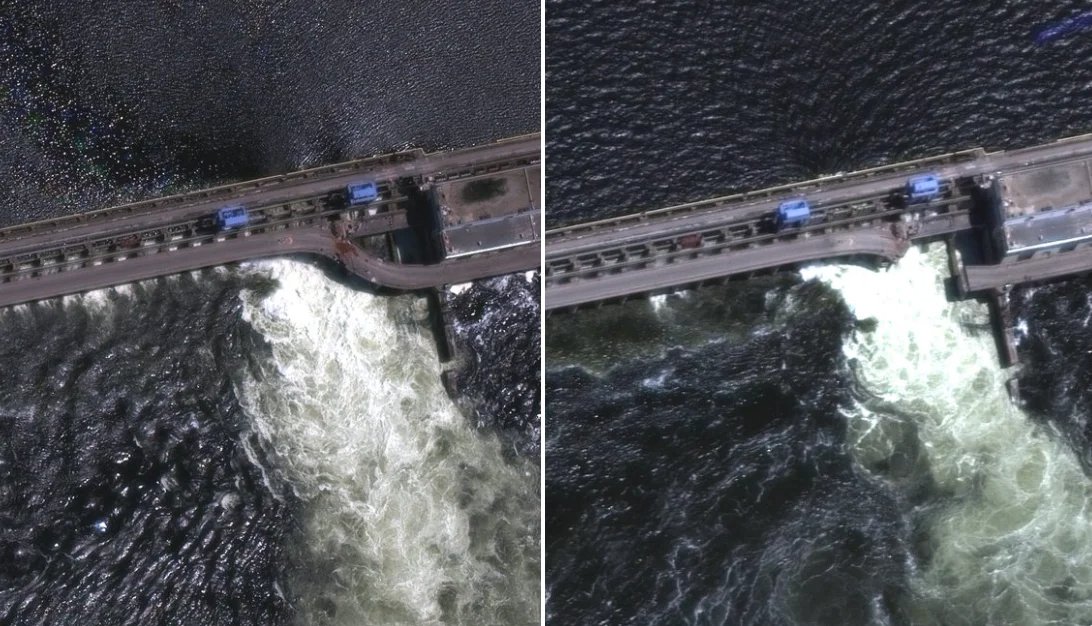The Ukrainian military claims that Russian forces have blown up the dam of the Kakhovka HPP in the Kherson region of Ukraine. Russian military bloggers, in their turn, have accused Ukraine of the explosion. Evacuation has been declared on the right bank of the Dnipro River. The level of water rose by 10 metres, the city of Novay Kakhovka is flooded. Volodymyr Zelensky has called an emergency session of the National Security and Defence Council of Ukraine. Main highlights.

Destruction of the dam
Russian forces have blown up the dam of the Kakhovka Hydroelectric Power Plant, as per the Operational Command South.
“Currently, the scale of the destruction is being looked into, the speed and volume of the water, the possible flooded areas. All service crews are on the scene,” the the statement reads.
Russia-appointed “Mayor” of the city of Nova Kakhovka Vladimir Leontyev at first called the reports about the explosion “nonsense” and claimed that “everything is fine in the city, it’s all quiet and peaceful”. However, later on he reported that at around 2 AM “there were multiple strikes on the Kakhovka HPP which destroyed the ‘valves.’”
“As a result, the water from the Kakhovka reservoir has started to flow uncontrollably downstream,” he said.
He added at a later time that the level of water after the destruction of the dam had risen 2.5 metres downstream. Russia’s state news agency TASS reported, citing emergency services, that 11 out of 28 spans had been destroyed, around 80 villages and towns are at risk of flooding.
Ukrainian governor of the Kherson region Oleksandr Prokudin confirmed the destruction of the dam and said that the water would reach critical levels within five hours.
The Korabel micro district in the city of Kherson saw private houses and garages get flooded. The water continues rising, Ukraine’s Suspilne Kherson reports. The micro district has been left without power and gas for safety purposes, the head of the Kherson region military administration Roman Mrochko said.
TASS also reported, citing a government source, that the dam had collapsed due to the damage. “There were no attacks. The dam just collapsed, one of the pillars caved in, and the flooding started”, the source claimed.
Ukrainian Telegram channels have been posting videos of, allegedly, the dam collapsing.
The level of water downstream is rising quickly. As of 11 AM local time, the water rose by 10 metres, Russia-appointed “Mayor” Leontyev said. A street in the city of Nova Kakhovka is already under water.
As of 12:20 PM local time, the city of Nova Kakhovka has been flooded, Russia-appointed “authorities” of the city report. State of emergency has been declared in the Nova Kakhovka city district.
The reliability of the Zaporizhzhia NPP is at risk, it could end up without cooling: “The water from the Kakhovka reservoir is necessary so that the plant receives energy for condensers of the turbines and the NPP’s security systems,” Ukraine’s Energoatom said in a statement. Crimea could face shortages of water following the collapse.
Following the explosion in the machine room from the inside, the Kakhovka HPP has been completely destroyed, the station cannot be restored, state company Ukrhydroenergo that controls Ukraine’s HPPs said in a statement.
Russian military bloggers, in their turn, are accusing Ukrainian servicemen of the dam collapse.
During a Bucharest Nine meeting, Ukraine’s President Volodymyr Zelensky said that the Kakhovka HPP had been mined.
“Russia has been controlling both the dam and the entire Kakhovka HPP for over a year.
It’s impossible to blow it up from the outside, through shelling, physically impossible. It was mined.
Mined by Russian invaders and blown up by them too,” Zelensky claimed.
The Ukrainian president also called the dam break “the biggest man-made environmental catastrophe in Europe in decades”. He emphasised that the Kakhovka water reservoir is a source of potable water for millions of people, farming, and agriculture.
“Russia has blown up a bomb of mass environmental destruction. And this is a true ecocide,” Zelensky added, as quoted by Ukrainian newspaper Strana.

Images from 28 May on the left and from 5 June on the right. Photo: Maxar
OSINT specialists speculate that the HPP dam could collapse due to the damage suffered in the past weeks and not because of an explosion, as media outlet Agentstvo points out.
Journalists from The Washington Post and Financial Times Evan Hill and Christopher Miller have noted that in the period between 28 May and 5 June “a section of the roadway and sluice gates had been recently damaged or destroyed”.
According to the satellite images, the Kakhovka water reservoir reached unprecedentedly high levels not long before the dam break, Hill writes. As per The New York Times, this could have been a consequence of the Russian occupation “government” keeping too few gates open.
The founder of Conflict Intelligence Team Ruslan Leviyev points out that water discharge can be seen on the images taken before the dam break. “Judging by this water discharge under the fallen stretch of the road (on the 5 June image), the dam gradually collapsed on its own. This could be why a part of the road fell down, considering that there was a hole there for a long time. I would take a look at older images, when this water discharge started appearing,” he wrote.
Leviyev also quotes a video showing an alleged ex-employee of the HPP saying that there was no attack on the building. At the same time, eyewitnesses told The Economist about a “deafening explosion” that could be heard in Kakhovka in the morning, correspondent of the outlet Oliver Carroll reports.
Ukrainian investigation outlet Schemes has posted the first satellite images of the destroyed Kakhovka HPP. The fresh images by Planet Labs dated 6 June 2023 show the aftermath of the dam break. When compared to the image from 4 June one can see that almost the entire HPP is destroyed, journalists note.
Evacuation of the population
Ukraine’s Ministry of Internal Affairs has declared evacuation of civilians from the potential flooding areas on the right bank of the Dnipro River. The ministry warned that the villages of Mykolaivka, Olhivka, Livo, Tyahynka, Ponyativka, Ivanivka, Tokarivka, as well as a part of the city of Kherson — the Korabel island — are at risk of flooding.
Residents of the villages and towns near the Dnipro River are asked to collect their documents and wait for evacuation buses.
Around 300 houses in the villages of Dnipryany and Korsunka on the outskirts of Nova Kakhovka could end up in the flooding area, they are located downstream, Leontyev said. The residents of these houses are being evacuated by buses. “There’s no risk of the city and villages being destroyed. However, sewer stations are already flooded, and a part of power lines is destroyed because the water is streaming uncontrollably in a powerful flow,” he added.
Reactions from Ukraine and Russia
Ukraine’s President Volodymyr Zelensky has called an emergency session of the National Security and Defence Council.
“Russian terrorists. The destruction of the Kakhovka hydroelectric power plant dam only confirms for the whole world that they must be expelled from every corner of Ukrainian land. Not a single metre should be left to them, because they use every metre for terror. It’s only Ukraine’s victory that will return security. And this victory will come. The terrorists will not be able to stop Ukraine with water, missiles or anything else. All services are working. I have convened the National Security and Defence Council,” he said in a Telegram post.
The Prosecutor General’s Office of Ukraine has initiated a pre-trial investigation into the destruction of the dam — on the counts of ecocide and violating the laws and customs of war. According to the Ukrainian office, on 6 June 2023 around 3 AM, Russian forces blew up the Kakhovka HPP, following which the water level started rising and settlements located near the Dnipro River began getting flooded.
The Kremlin spokesperson Dmitry Peskov has called the destruction of the Kakhovka HPP a “premeditated sabotage” carried out by Ukraine. According to him, Ukraine’s army blew up the dam due to the lack of successes in the counteroffensive. Russia, Peskov says, “categorically denies” the accusations of its involvement in the attack on the Kakhovka HPP. Peskov adds that Putin is receiving reports on the situation from the Defence Ministry and other ministries.
Russia’s Defence Minister Sergey Shoigu has accused Kyiv of blowing up the Kakhovka HPP facilities which led to “the flooding of significant territories”. According to Shoigu, Ukraine’s goal was to weaken the positions of Russian troops in the Kherson direction.
Zelensky talked about Russia blowing up the dam last autumn
Back in October 2022, Zelensky talked about the consequences of the dam being blown up and about the fact that the “units and dam of the Kakhovka HPP are mined by Russian terrorists”. According to the president, the dam of the plant controlled by the Russian army maintains the volume of 18 million cubic metres of water and if it were to be blown up over 80 villages and cities, including Kherson, would be at risk of instant flooding.
“The dam being undermined would mean a big-scale catastrophe. Of course, we understand that the invaders do not care what happens to the territory of Ukraine. With this terrorist attack, they could destroy, among other things, even the possibility of Crimea receiving water supply from Dnipro. The North Crimean Canal will just disappear in case the Kakhovka HPP dam is destroyed,” the Ukrainian president said back then.
In November 2022, satellite images and videos of the damage done to the dam were posted. The dam was blown up during the retreat of Russian forces from Kherson. The images of destroyed Antonivka and Darivka bridges were posted as well.
